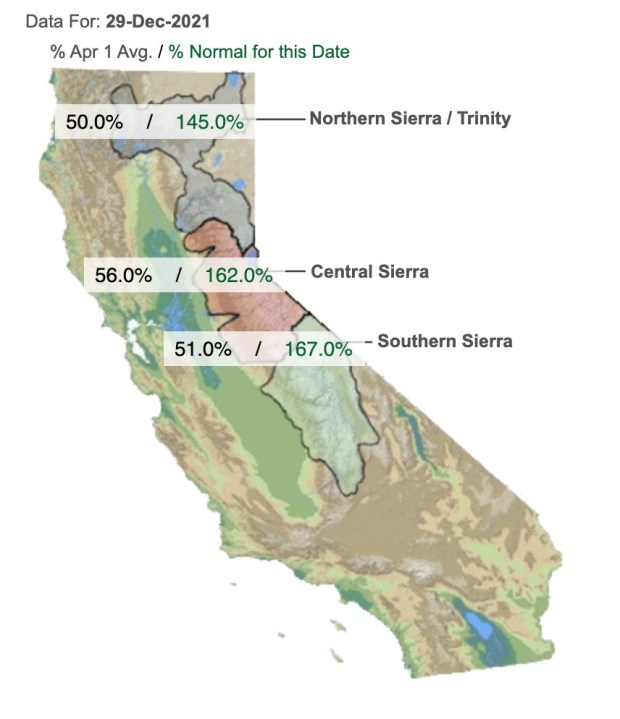A series of winter storms in the Sierra Nevada has wreaked havoc on the region over the past week as heavy snowfall forced the closure of local highways, buried towns in piles of fresh powder and rendered some areas completely impassable.
But the snow has also bolstered the badly depleted Sierra snowpack at a time when drought-stricken California desperately needs the critical water supply source to recharge.
Snowpack bouncing back
As of Wednesday, the Southern Sierra’s snow water equivalent measured 167% of average for this date, while the Central Sierra and Northern were at 162% and 145% respectively, according to the California Department of Water Resources.
Those figures haven’t been that high for a Dec. 29 since 2010, when some parts of the snowpack weighed in at 200% of average at the time, records indicate.
For comparison, the measurements were between 33 to 61% normal on Dec. 29, 2020. At the beginning of this month, the range was 21 to 51%.
The numbers are important because about 30 percent of California’s water storage comes from the snowpack when it melts in late spring to summer and replenishes the state’s reservoirs. Most of those reservoirs remain below the historical average.
More information about the snowpack will likely be released Thursday, when the Department of Water Resources conducts the first live snow survey of the winter at Phillips Station.
Major snow slams Sierra
California’s key water source is being aided by sizable snowfall totals in the Sierra range, which has been socked by snow throughout December.
This week, Lake Tahoe smashed a 50-year-old record for its snowiest December when the total there reached 193.7 inches, according to the University of California Berkeley’s Central Sierra Snow Lab.
The snow lab — which is in the Donner Pass — has since received more snow, reporting a monthly total of 210 inches as of Wednesday morning.
Other areas of the mountain range have also had impressive amounts of snow recently.
At the Northstar resort in Lake Tahoe, a whopping 134 inches has fallen in just the past seven days, making up nearly half of the seasonal snowfall total thus far.
And Mammoth Mountain, which is in the Eastern Sierra, is on track to have its second-highest snow total for a December, with 161 inches to date this month. Including October and November, the resort is now about 50 inches away from surpassing its snowfall total for the entire 2020-2021 season, which was 244 1/2 inches, Mammoth records show.
Forecasters predict light snow showers in the Sierra through New Year’s Eve, with up to 2 inches possible in some parts. Heavy snow is expected to return to the range next week, according to the National Weather Service.






















